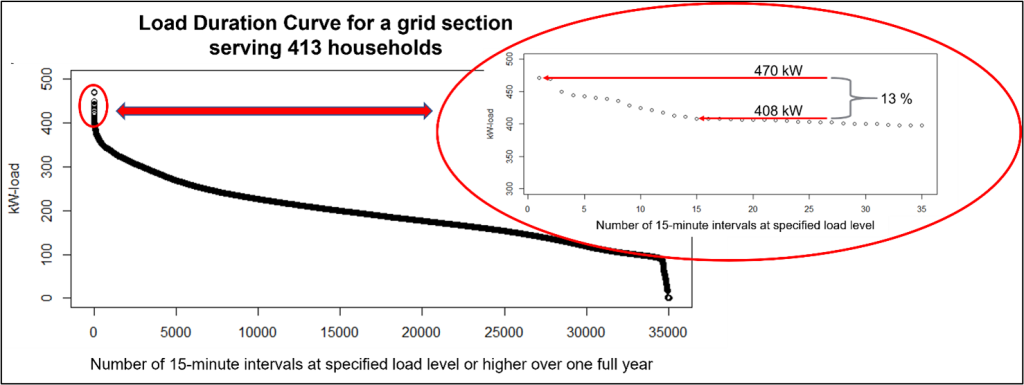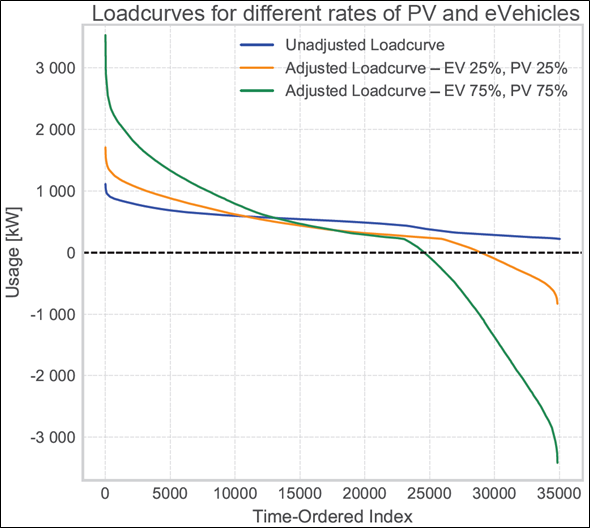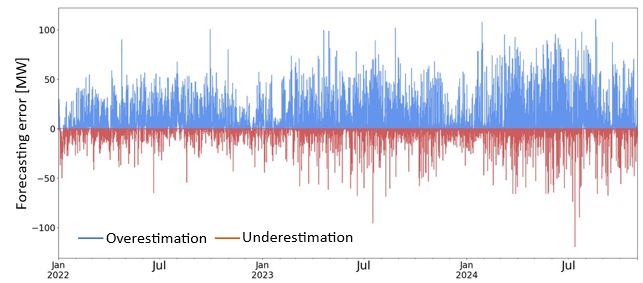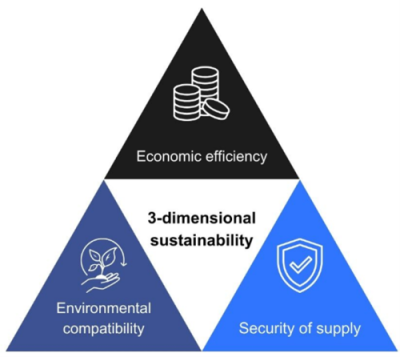Univ.-Prof. Dr. Johannes Reichl (JKU Linz)
Univ.-Prof. Dr. Peter Filzmoser (TU Wien)
Project description
Motivation
The European Climate Law [1] commits the EU to carbon neutrality by 2050, with renewables accounting for nearly 47% of electricity generation in 2024 [2]. The volatility of renewable generation, its geographic distribution, and smaller plant sizes demand major upgrades to Europe’s power grids, including sufficient storage capacity. The costs of upgrading the power grids are expected to be in the trillions of € range; a recent analysis [3] estimates aggregated costs in the EU until 2040 of 2300 bn €. For Austria alone, this would accumulate around 50 bn. € of required investments. The cost of adapting power grids for 100% renewables depends more on peak capacity (kW/GW) than on total energy (kWh/GWh) transported. Traditional engineering principles – such as Austria’s Technical and Organisational Rules (TORs) for grid operators and users, introduced by the regulatory authority E-Control [4] – were developed prior to the availability of modern computational tools for load forecasting and control. Hence, these semi-legal standards define the required amount of grid capacity to be installed for a certain power line to be large enough for accommodating the expected peak loads in a scenario without demand and production flexibility. However, such peak loads occur infrequently, meaning that for the vast majority of its lifetime, a grid section is significantly — and expensively – overdimensioned. Figure 1 provides an illustrative example of how required grid capacity is driven by only a share of periods with high electricity demand, suggesting that the same grid could transport more than twice as much energy – if loads were distributed more evenly across time. This leads to the optimistic hypothesis, that the aforementioned high investment costs for making the grid fit for a 100% renewable electricity system could be significantly reduced if computational methods enable new TORs and regulatory policies to utilize the existing grid in a more cost-effective way. Electricity grid upgrades remain essential, but with expected investments exceeding €1 trillion, every percentage point saved could ease the burden on EU consumers by over €10 billion.

Tentative Research Plan
The proposed dissertation addresses the development of a toolset i.) to support grid operators in their planning processes, and ii.) to simulate the impact of candidate regulatory mechanisms that could potentially lead to flattening the load duration curve and thereby saving investment costs. Figure 1 illustrates the challenge of positive peak loads – periods of highly concentrated demand. More recently, however, the rise of significant amounts of volatile renewable generation capacity, such as photovoltaic (PV) systems, has introduced a new challenge: negative peak loads. These occur when PV and wind generation significantly exceed local demand, often necessitating grid upgrades specific to this type of peaks for maintaining grid stability – see Figure 2.
A key prerequisite for many planning processes of grid operators, as well as regulatory policies aiming at reducing positive or negative peaks, are precise forecasting methods of respective peaks; for an overview of recent methods see [5,6]. Such “early warning” will allow activating technical or economic measures for flattening the curve before such peaks would unleash their threatening impact on power frequency and grid stability [7]. Hence, the first research question (RQ#1) addresses the identification and improvement of methods for forecasting load events that require (automated) attention for keeping the grid stable. However, traditional methods (as currently still applied by most grid operators) are far from sufficient accuracy for depending such technical or economic measures on them, as they neglect the capabilities of recent computational developments. One reason is that they rely on (econometric) modelling techniques that assume a set of explanatory variables as time-independent for a certain grid area and period of interest (e.g. installed PV capacity, electric vehicles, storage). Although PV systems must be registered with the local grid operator, a significant number are likely unregistered, making it difficult to accurately predict electricity demand. The same challenge applies to electric vehicles (especially private home charging) and battery storage systems. As a result, models are estimated based on static data, and forecasts are made without updating these explanatory variables despite their dynamic change; significant forecasting inaccuracies are inevitable – see Figure 3 for exacerbating forecasting errors where traditional models are not dynamically updating the explanatory data and model. Hence, RQ#1 will go beyond identifying new modeling techniques from the fields of machine learning and deep learning. It will also aim to move beyond the current estimation paradigm that relies on predefined explanatory variables, by developing methods that treat these variables as parameters to be estimated themselves. This includes scraping data for the estimation from regularly updated and reliable sources (e.g. applications for PV system connections, together with public sales statistics of PV components). Results for RQ#1 will be improved forecasting methodology i. directly applicable by grid operators for usage in their mandatory load flow analysis. Thereby supporting to maintain the reliability of the grid despite the challenges of the energy transition, and reducing balancing costs [8] from errors in the forecasts. RQ#1 results will also be used ii. as an input to the second main research question of the Dissertation, RQ#2, exploiting the improved forecasting techniques and developing a simulation environment to test candidate regulatory policies to prevent (or limit) the harmful load events. Such candidate policies include, for example, dynamically limiting the feed-in of PV-generated electricity into the grid when forecasts predict a critical negative peak load situation, or penalizing the charging of high-capacity electric vehicles during opposite peak load conditions. The result of RQ#2 is to provide lawmakers a tool for assessing candidate measures’ impact on reducing the need of extensive and expensive grid infrastructure enhancements, while safeguarding grid stability.
The initial research step is to develop digital twins1 of selected grid areas on two different grid levels, i.e. low voltage level (referred to as NE7) and medium voltage level (referred to as NE5)2. Data will be provided by the energy utilities of Vienna and Linz, serving urban as well as surrounding rural areas – see the box below “Industry Interest and Data Support”. These digital twins of real grid areas are then enriched by additional PV, wind turbines, e-vehicles, heat pumps, battery storage systems, etc., to provide different levels of future energy transition scenarios, and to have knowledge on the household-level key drivers of the loads (this information is incomplete in practice, see RQ#1) – see Figure 2 for a simplified example at NE7. To address RQ#1, in iterative loops, unsupervised learning methods are applied and refined to estimate the number and capacity of PV systems, electric vehicles, and batteries within the respective digital twin. These estimates of equipment within the grid area are subsequently used as inputs to develop and fine-tune supervised learning models for load forecasting. Looping is continued until no further progress over the forecasting methods currently applied by the grid operators of Vienna and Linz are observed. Literature provides no sources for the unsupervised part in light of our application, while applications to comparable challenges make Blind Source Separation (BBS) [9] and Physics-Informed Neural Networks (PINN) [10] promising candidates. While BSS leverages the recurring patterns in load profiles – such as those generated by PV systems – to isolate their contributions from the aggregated total load, PINNs incorporate physical relationships, such as the dependence of PV output on solar irradiance, to estimate their share of the overall load curve. Further methods will be tested, and research will include ideas how to improve the methods by exploiting tentative information available from public sources, like sales numbers of PV panels and e-vehicles, or satellite data (e.g. high resolution pictures of houses’ roofs). For the supervised second part of the loop, the estimated equipment is used as explanatory variables in the actual load forecasting. We select a number of promising methods from the econometric class of methods, such as autoregressive methods like SARIMAX [11], as well as from the machine learning domain, like recent approaches in adaptive deep-learning [12] and neural hierarchical interpolation [13].

For RQ#2, a simulation environment is developed, that again uses the digital twins at its core. The forecasting results related to RQ#1 provide the predicted positive or negative aggregated load at grid nodes, and together with grid operators thresholds for maximum or minimum acceptable load values are defined. Forecasts exceeding the thresholds are respective points of action in the simulation (well aware that these will contain false positive and false negative projections). Based on existing (e.g. [14]) and by then completed research3, sensitivity of customers to short-term price changes, i.e. demand elasticities, are derived, and their potential impact on the load curves is implemented. Candidate policy measures are designed, such as high-tariffs at times of projected aggregated demand peaks, or low (and possibly negative) tariffs when high amounts of PV production create a threat to grid stability. Notice: such tariffs will not be in place at any time, because individual positive or negative peaks do not threaten the grid, but become critical in case of high simultaneity only – which is the objective of our forecasts.

Literature References
[1] European Commission, 2021. Regulation (EU) 2021/1119 of the European Parliament and of the Council of 30 June 2021 establishing the framework for achieving climate neutrality (‘European Climate Law’). Official Journal of the European Union L243. https://eur-lex.europa.eu/eli/reg/2021/1119/oj/eng
[2] European Commission, 2025. Electricity from renewable sources reaches 47% in 2024. Eurostat News, March 19, 2025. https://ec.europa.eu/eurostat/web/products-eurostat-news/w/ddn-20250319-1
[3] Hoffmann, P., Krichene, H., Zimmer, M. and M. Mier, 2025. Plug, baby, plug: Unlocking Europe’s electricity market. Special Report of Allianz Research, Munich. https://www.allianz.com/en/economic_research/insights/publications/specials_fmo/250311-electricity-market-europe.html
[4] E-Control Austria, 2024. Technical and Organizational Rules for Operators and Users of Networks (TOR). Retrieved April 7, 2025, from https://www.e-control.at/marktteilnehmer/strom/marktregeln/tor
[5] Hong, T., Pinson, P., Wang, Y., Weron, R., Yang, D., and H. Zareipour, 2020. Energy forecasting: A review and outlook. IEEE Open Access Journal of Power and Energy, 7, 376-388. https://doi.org/10.1109/OAJPE.2020.3029979
[6] Nti, I. K., Teimeh, M., Nyarko-Boateng, O., and A. F. Adekoya, 2020. Electricity load forecasting: a systematic review. Journal of Electrical Systems and Information Technology, 7, 1-19. https://doi.org/10.1186/s43067-020-00021-8
[7] Azarova, V., Cohen, J. J., Kollmann, A. and J. Reichl, 2020. Reducing household electricity consumption during evening peak demand times: Evidence from a field experiment. Energy Policy 144, 111657. https://doi.org/10.1016/j.enpol.2020.111657
[8] Belmonte, B.B., Mouratidis, P., Franke, G. and S. Rinderknecht, 2023. Developments in the Cost of Grid Balancing Services and the Design of the European Balancing Market. Energy Reports 10, 910-931. https://doi.org/10.1016/j.egyr.2023.07.045
[9] Naik G. R. and W. Wang, 2014. Blind Source Separation: Advances in Theory, Algorithms and Applications. Springer Publishing Company, ISBN:978-3-642-55015-7. https://link.springer.com/book/10.1007/978-3-642-55016-4
[10] Raissi, M., Perdikaris, P. and G. E. Karniadakis, 2019. Physics-informed neural networks: A deep learning framework for solving forward and inverse problems involving nonlinear partial differential equations. Journal of Computational Physics 378, 686-707. https://doi.org/10.1016/j.jcp.2018.10.045
[11] Elamin, N., and M. Fukushige, 2018. Modeling and forecasting hourly electricity demand by SARIMAX with interactions. Energy, 165, 257-268. https://doi.org/10.1016/j.energy.2018.09.157
[12] Gao, J., Chen, Y., Hu, W., and D. Zhang, 2023. An adaptive deep-learning load forecasting framework by integrating transformer and domain knowledge. Advances in Applied Energy, 10, 100142. https://doi.org/10.1016/j.adapen.2023.100142
[13] Challu, C., Olivares, K. G., Oreshkin, B. N., Ramirez, F. G., Canseco, M. M., and A. Dubrawski, 2023, June. Nhits: Neural hierarchical interpolation for time series forecasting. In Proceedings of the AAAI conference on artificial intelligence (Vol. 37, No. 6, pp. 6989-6997). https://doi.org/10.1609/aaai.v37i6.25854
[14] McKenna, R., Hernando, D. A., Brahim, T. b., Bolwig, S., Cohen, J. J. and J. Reichl, 2021. Analyzing the energy system impacts of price-induced demand-side-flexibility with empirical data. Journal of Cleaner Production 279, 123354. https://doi.org/10.1016/j.jclepro.2020.123354
- In this dissertation, digital twins refer to aggregates of anonymized 15-minute load curves, designed to ensure full privacy protection. These digital twins do not include network topology, as both the forecasts used in load flow analyses and relevant regulatory frameworks rely on measured load data rather than topological information in practice. ↩︎
- For an explanation of grid levels in Austria see the website of the Austrian transmission system operator APG: https://markt.apg.at/en/electricity-market/austrian-electricity-market-model ↩︎
- The project INNOnet experiments the impact of load-based grid tariffs on grid customers’ behaviors and data will become available by end of 2025 https://projekte.ffg.at/projekt/4478292 ↩︎
About the Hosting Institute
The Future Energy Lab (FEL) at Johannes Kepler University Linz is a recently established research platform dedicated to advancing Europe’s energy transition. As it is still in its starting phase, FEL offers an exceptional opportunity for new team members and doctoral candidates to influence its development and shape its research agenda through their own contributions. The lab brings together expertise in economics, econometrics, and behavioural sciences with insights from law, policy, and data science to tackle the pressing challenges of modern energy systems. Designed as a hub for interdisciplinary research, FEL combines advanced quantitative methods with real-world policy and market applications, making it an ideal environment for PhD candidates in quantitative energy modelling and forecasting.
At the core of its research, the Future Energy Lab addresses the challenges of the energy policy triangle (see Figure 1), which captures the balance between economic efficiency, environmental compatibility, and security of supply. FEL investigates how these three dimensions of sustainability interact and sometimes conflict, and how innovative modelling, forecasting, and policy design can help reconcile them. By studying questions of cost-effectiveness, ecological impact, and resilience of energy systems in an integrated way, the lab contributes to shaping strategies that achieve 3-dimensional sustainability.

– which guide the research focus of the Future Energy Lab. © LIT Future Energy Lab, Univ.-Prof. Dr. Johannes Reichl
The FEL puts a strong focus on forecasting and modelling. Researchers employ state-of-the-art econometric approaches, statistical time-series methods, and machine learning techniques to anticipate energy demand, assess supply security, and explore scenarios for climate neutrality. Topics include demand-side flexibility, renewable integration, adequacy metrics, peak load forecasting, and the evolving role of prosumers in energy communities. These projects are not purely theoretical: they are directly linked to empirical datasets, field experiments, and regulatory applications. PhD candidates thus find themselves working in an environment where models are tested against real-world conditions and where their research outputs can directly inform energy policy and market design.
FEL is deeply embedded in international research networks and builds on the strong track record of its founding team. Projects such as PEAKapp (digital applications for household energy savings), eCREW (renewable energy communities), CAMPAIGNers (citizen climate engagement), and openENTRANCE (transition scenarios for a low-carbon Europe) highlight the variety of the lab’s members’ experience. These initiatives have demanded sophisticated modelling of consumer behaviour, tariff impacts, and system-level transitions, creating a wealth of methodological expertise that new doctoral researchers can build upon. For PhD candidates, this means not only access to high-quality datasets and international collaborations but also the chance to leave their mark on the design of ongoing and future projects.
Close links to regulators and policy institutions further strengthen FEL’s research profile. Studies for the EU Agency for the Cooperation of Energy Regulators (ACER) and Austrian authorities—on issues such as the Value of Lost Load, the Cost of New Entry, and reliability standards—demonstrate how FEL’s quantitative analyses are translated into regulatory practice. PhD candidates working in this setting gain valuable experience at the science–policy interface, learning how advanced modelling can be used to shape European market design and energy governance. This exposure makes FEL an attractive environment for students who want to combine academic rigour with societal impact.
Another defining feature of FEL is its commitment to interdisciplinarity. While quantitative modelling is at the centre, research at FEL is always framed by broader social, legal, and governance perspectives. Energy systems are not analysed solely as technical structures, but as socio-technical systems embedded in political and cultural contexts. For doctoral students, this means learning to situate their modelling work within debates on climate neutrality, energy justice, and digitalisation. By contributing to this integrated research environment, new PhD candidates can help shape how FEL defines its role at the intersection of energy science, society, and policy.
The research culture at FEL is characterised by openness, collaboration, and the dynamism of a lab in its formative stage. Doctoral researchers are encouraged to take initiative, propose innovative approaches, and actively shape the direction of their projects. They become part of a team that brings together senior researchers, postdocs, and international partners, while also offering room for new members to make substantial contributions. FEL regularly organises seminars, workshops, and guest lectures, fostering exchange with leading scholars and practitioners. PhD candidates are supported in publishing their work, presenting at international conferences, and developing an academic profile that prepares them for careers in research, policy, or industry.
In sum, the Future Energy Lab is an outstanding place to pursue doctoral research in quantitative energy modelling and forecasting. Its starting phase offers unique opportunities: new PhD candidates are not only joining a vibrant interdisciplinary lab, but also helping to shape its identity and research trajectory. With its combination of methodological excellence, policy relevance, and openness to new ideas, FEL provides the perfect setting for doctoral students who want to contribute to Europe’s energy transition while developing their own research agenda and academic careers.
About the Principal Investigator / PhD Supervisor
Johannes Reichl, born in 1979, is Professor of Energy Economics and Applied Econometrics at Johannes Kepler University Linz (JKU). He also serves as Scientific Director of the Department of Energy Economics at the Energy Institute and as Head of the interdisciplinary LIT Future Energy Lab. His academic path started with a Master’s degree in Statistics at JKU (2004), followed by a doctorate in 2009 and a habilitation (teaching qualification) in Econometrics in 2022.
Over the past two decades, Reichl has built a career at the interface of statistics, economics, and energy policy. After early work as a research assistant at the Energy Institute (2006–2009), he went on to manage large national and international research projects before becoming scientific director in 2023. He held guest and visiting positions at Izmir University of Economics (2021) and Virginia Tech University (2013), and has contributed to European standardisation efforts in energy economics and efficiency.
His research focuses on energy markets, supply security, behavioural and socio-economic aspects of the energy transition, and applied econometrics. A strong emphasis lies on empirical modelling and field experiments in areas such as demand-side flexibility, renewable energy communities, and household energy behaviour. To bridge research and application, he has developed tools like the Blackout Simulator, the EU-funded PEAKapp, and the Climate Campaigners platform.
Reichl has published in leading international journals including Nature Energy, Energy Economics, Global Environmental Change, and Monte Carlo Methods and Applications. His work covers methodological contributions in econometrics as well as applied studies on climate policy, demand response, energy efficiency, blackout economics, and the acceptance of new energy infrastructures. In addition, he co-edited Political Economy and Instruments of Environmental Politics (MIT Press, 2015) and serves as co-editor of the European Energy & Climate Journal.
He is actively engaged in policy and regulatory dialogue at European and national levels. For the EU Agency for the Cooperation of Energy Regulators (ACER) and national regulatory authorities, he has led high-profile studies on adequacy metrics, reliability standards, and the value of lost load. He has contributed as keynote speaker, moderator, or panelist to international conferences and workshops organised by the European Commission, the European Parliament, the Florence School of Regulation, and the OSCE.
A hallmark of his academic activity is the coordination and leadership of large-scale research projects. He has served as coordinator and principal investigator of several Horizon 2020 projects (CAMPAIGNers, eCREW, PEAKapp). Further, his work includes leading roles in projects on energy storage (Store & Go), grid security (SESAME, SPARKS), and blackout resilience (BlackO.1, BlackO.2). These projects, many of which involved large international consortia, highlight his expertise in combining quantitative research with interdisciplinary, policy-relevant approaches.